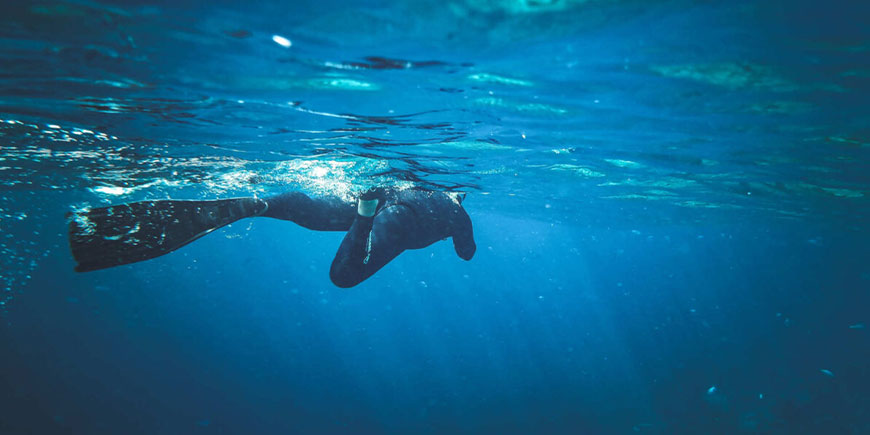Diving Medicine deals with preventing and treating diving related health problems.
Both free diving and scuba diving are increasingly popular sports that allow us to explore the unknown and enjoy unique adventures and experiences. In addition, technological advances have made diving much safer than in the past.
However, to be honest, there is no such thing as zero risk for humans when diving underwater. Hence the importance of diving medicine.
What is diving medicine?
Immersion in water is an extremely unnatural condition for the organism and has important effects on the human body, which can be therapeutic, but also serious health risks for divers.
Diving medicine is concerned with the diagnosis, treatment and prevention of diseases related to diving, whether apnoea or snorkelling, and the prevention of accidents and illnesses in the water.
As well as determining and assessing the physical requirements for diving, this complex discipline studies the effects of diving on the human body through the effects of water pressure on the body. There are certain organs which are particularly affected by this phenomenon and which must be in optimal health for safe diving. These include the ears, sinuses, heart, lungs and vascular system.
From diving medicine comes hyperbaric therapy, the use of high-pressure oxygen to treat dysbaric disorders. Hyperbaric chambers (or decompression chambers) are used to create this environment, and their effects are so beneficial to health that they are now being used to treat other conditions. They take their name from the decompression stops typical of a diver’s ascent to the surface.
Diving medicine physician
Diving doctors are specialists in a unique area of medicine that encompasses both underwater and hyperbaric health. Their expertise ranges from understanding how the human body reacts underwater and at different pressure levels to mastering the equipment and procedures used in diving.
These professionals not only assess whether a person is fit to dive but they are also trained to diagnose and treat diving-related accidents, such as decompression sickness.

Pre-dive medical examination
Recreational diving is the best known and most widely practised form of recreational diving, both free diving and scuba diving. It poses very few health risks for most people; however, certain physical conditions can increase the risks, sometimes not obvious to beginners who want to try scuba diving.
A thorough examination by a specialist is therefore essential in order to make an assessment:
- Mental health: It is crucial to assess whether a candidate has the capacity to learn and apply theoretical diving knowledge, as well as observe their behavior in the training environment.
- General health, they need to be controlled:
- The otorhinolaryngological system is vital for divers, as any pressure imbalance during ascent and descent can cause anything from discomfort to injuries.
- Medical conditions related to the cardiovascular, gastrointestinal, hematological, endocrine, and neurological systems, as they can affect the diver’s safety.
In summary, the medical evaluation of potential divers should be comprehensive and personalized, considering all these aspects to ensure the safety and well-being of individuals during dives.
The effects of diving on the human body
Hyperbaric chamber decompression is used to treat two of the most common conditions affecting divers, decompression sickness and arterial gas embolism.
These two pathologies, which are practically opposite types of diving, have essentially the same cause: the change in pressure to which the gases naturally present in the human body are subjected.
Pressure causes major changes in the middle ear, blood circulation and respiration: not surprisingly, these are called barotraumatic events, i.e. caused by changes in external pressure.
The Boyle-Mariotte Law states that “the volume of a given quantity of gas varies inversely with the pressure to which it is subjected“, which means that as you descend to depth, the volume of gases in your body and equipment gradually compresses, and as you return to the surface, it increases.
This applies to all the gases in the blood (oxygen, nitrogen, carbon dioxide), but it is nitrogen in particular that poses a danger to divers: this gas is actually inert and is stored in the tissues as it is, without being converted by respiration.
Under natural conditions, nitrogen is gradually released as a gas during exhalation. However, the decompression experienced during ascent from a dive can result in an excessive release of nitrogen in gaseous form (known as nitrogen ‘bubbles’), which the diver is unable to eliminate by breathing and which can lead to gas embolism and organ damage.
Decompression sickness: the dangers of ascent
Diving medical emergencies are extremely rare. It is estimated that they occur only twice in every 10,000 dives. But you have to be prepared.
Most diving related injuries are caused by barotraumatic events: nitrogen narcosis (in deep dives), CO2 absorption and oxygen toxicity (at extreme depths) are directly caused by pressure changes, as are various middle and inner ear disorders.
However, the two most feared conditions in diving medicine are decompression sickness (MDD), which is typical of scuba divers, and arterial gas embolism, which is more common in freedivers.

Decompression sickness: what it is and when it happens
Decompression sickness can occur if you ascend to the surface too quickly or if you do not take the necessary decompression stops during your ascent. The air contained in scuba tanks is actually 79% nitrogen, the inert gas which, as we have seen, is in danger of being released too violently due to the sudden drop in pressure.
The image most often used to describe the decompression of nitrogen in the body is that of a can of very fizzy drink: when the can is opened and the pressure released, the gas is released explosively, creating bubbles that the cap cannot hold and release in a controlled manner.
Diving medicine and apnoea: Arterial gas embolism
Arterial gas embolism, on the other hand, is more common in apnoea patients and is directly related to the Boyle-Mariotte law. From a depth of 0 to 10 metres, the pressure increases from 1 to 2 bar: this means that when you ascend from 10 metres to the surface, the volume of air in your lungs doubles, which can rupture the alveoli.
“Never stop breathing” is one of the basic rules of apnoea and diving in general: regulating the amount of air in the lungs by gradually exhaling is precisely what balances lung pressure during ascent.
The proliferation of apnoea diving, especially at great depths, has also focused attention on other compensation mechanisms that are essential for divers, such as those needed to avoid ear decompensation, which is one of the most common, especially among less experienced divers.
How to treat decompression sickness
The treatment of decompression sickness often involves the administration of oxygen immediately after surfacing and hyperbaric oxygen therapy in decompression chambers on land.
However, it is important to note that the availability of treatment may be limited in some locations, which underscores the importance of prevention and education in the diving community. For this reason, recreational diving instructors and divemasters must have knowledge and skills in rescue and first aid, including certification in CPR and normobaric oxygen administration.


